
Lindberg 1/48 X-3 Stiletto
|
KIT # |
2335 |
|
PRICE: |
$? |
|
DECALS: |
One aircraft |
|
REVIEW : |
|
|
NOTES: |
Photo courtesy of USAF Museum |
"STAGGER LEE"
DOUGLAS X-3 "STILETTO"
USAF AND NACA
1952 - 1955

|
HISTORY |
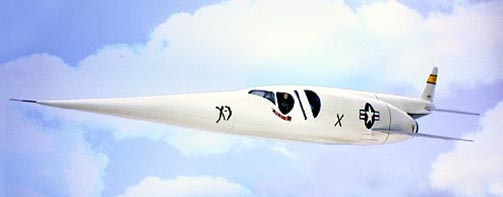
If ever there was an aircraft that looked its moniker, it was the X-3 "Stiletto". Under direction of the US Air Force's Air Research and Development Command, and sponsored jointly by the US Navy, USAF and NACA, Douglas designed and developed a high-speed research aircraft under the designation Douglas X-3, later named Stiletto after its lines. Intended primarily for research into the problems of high-altitude, high-speed flight and the effects of kinetic heating, the X-3 began its design life in 1946. The complexity of this program is indicated by the fact that more than three years elapsed before approval was given for construction of a mockup, in August 1948, and it was not until late June 1949 that Douglas received a contract for two flying prototypes and one static test airframe; however, only one prototype was built (49-2892).
The X-3 had the most highly refined supersonic airframe of its day as well as other important advances including one of the first machined structures. It included the first use of titanium in major airframe components. Its long fuselage gave the Stiletto a high-fineness ratio and a low-aspect ratio (the ratio of the wing's span to its chord; in other words, it was short and stubby). Despite this refined configuration, the maximum speed it attained was Mach 1.21, which occurred during a dive. The general consensus was that the aircraft was sluggish and extremely underpowered by its Westinghouse J-34 power plants. The X-3 also demonstrated coupling instability during abrupt rolling maneuvers, which could cause it to go wildly out of control, as happened on a flight on Oct. 27, 1954, with National Advisory Committee for Aeronautics (NACA) pilot Joe Walker at the controls. The principle contribution of the X-3 was its data on inertial coupling (roll divergence) - a tendency to diverge from the intended flight path. The aircraft also shed its small tires routinely, leading to a revision of the design criteria for tires used on high-speed aircraft. This aircraft flew 20 times between 1954 and 1956 at the NACA High-Speed Flight Station (predecessor of NASA's Dryden Flight Research Center, Edwards, California). Joe Walker was the pilot for all 20 of these missions.
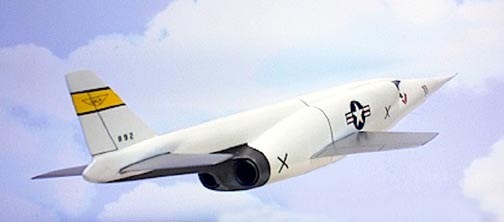 First flown on 20 October 1952 with Douglas test pilot Bill
Bridgeman in the cockpit, the X-3 had a slender needle-nosed fuselage, a low-set
cantilever monoplane wing of very short span, conventional tail unit,
retractable tricycle landing gear and power provided by two Westinghouse
J-34-WE-17 turbojets mounted side-by-side in the fuselage. The pilot was
accommodated in a pressurized cabin, on a downward ejection seat that served
also as an electric lift to provide access from the ground. Design of the X-3
was of unprecedented complexity because of the high-speed requirement, involving
advanced aerodynamics and the use of new constructional methods and materials.
They included, in particular, the development of fabrication and construction
techniques involving the use of titanium. Additionally, the airframe had more
than 850 pinhole orifices distributed over its surface to record pressures, 185
strain gauges to record air loads and stresses, and 150 temperature recording
points. Testing proved disappointing, the aircraft being underpowered and able
to achieve only 50 per cent of its design speed of Mach 2.2. With virtually no
hope of improving performance, the USAF cancelled the program after only six
flights and the aircraft was handed over to NACA.
First flown on 20 October 1952 with Douglas test pilot Bill
Bridgeman in the cockpit, the X-3 had a slender needle-nosed fuselage, a low-set
cantilever monoplane wing of very short span, conventional tail unit,
retractable tricycle landing gear and power provided by two Westinghouse
J-34-WE-17 turbojets mounted side-by-side in the fuselage. The pilot was
accommodated in a pressurized cabin, on a downward ejection seat that served
also as an electric lift to provide access from the ground. Design of the X-3
was of unprecedented complexity because of the high-speed requirement, involving
advanced aerodynamics and the use of new constructional methods and materials.
They included, in particular, the development of fabrication and construction
techniques involving the use of titanium. Additionally, the airframe had more
than 850 pinhole orifices distributed over its surface to record pressures, 185
strain gauges to record air loads and stresses, and 150 temperature recording
points. Testing proved disappointing, the aircraft being underpowered and able
to achieve only 50 per cent of its design speed of Mach 2.2. With virtually no
hope of improving performance, the USAF cancelled the program after only six
flights and the aircraft was handed over to NACA.
However, the X-3 was not regarded as a failure, for it made important contributions to titanium technology, and features of its design were used later in Lockheed's F-104Starfighter and the SR-71 Blackbird. The X-3 was transferred to the U.S. Air Force Museum in 1956, where it resides today.
|
CONSTRUCTION |
Interior:
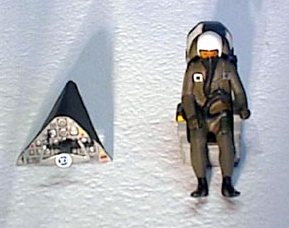 The kit includes a two-piece seat with a pilot figure. I
scratch built an instrument panel and shroud from sheet styrene. Cockpits parts
were painted dark gull gray with the shroud painted flat black. The instrument
gauges were done with Waldron punched disks of white trim film and reheat Models
instrument gauge decals. The control wheel was scratch built using styrene rod,
sheet, and a Waldron punched disk.
The kit includes a two-piece seat with a pilot figure. I
scratch built an instrument panel and shroud from sheet styrene. Cockpits parts
were painted dark gull gray with the shroud painted flat black. The instrument
gauges were done with Waldron punched disks of white trim film and reheat Models
instrument gauge decals. The control wheel was scratch built using styrene rod,
sheet, and a Waldron punched disk.
The figure was painted olive green with a different shade of olive used for the masking tape harnesses. The figure was hand painted after first airbrushing a gray primer.
Sidewall and side controls were scratch built with bits and pieces of styrene sheet, Waldron punched disks, and fine wire. Sidewalls were also painted dark gull gray with a couple of boxes painted semi-gloss black, A few Reheat Models control and data placards decals were utilized on both walls.
Engines and exhausts:
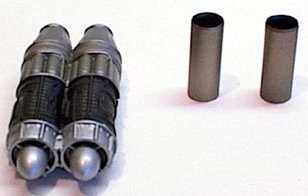 The kit contains a rather nice two-piece J-34 engine pair, but
the exhausts were non-existent. I easily scratch built the exhaust and exhaust
housing from two sizes of styrene tubing. The ends of both were cleaned out but
using a motor lathe. The housings were painted steel and the exhausts burnt
iron. The engines were painted gloss black, masked and the front painted bright
aluminum with the rear done in graphite.
The kit contains a rather nice two-piece J-34 engine pair, but
the exhausts were non-existent. I easily scratch built the exhaust and exhaust
housing from two sizes of styrene tubing. The ends of both were cleaned out but
using a motor lathe. The housings were painted steel and the exhausts burnt
iron. The engines were painted gloss black, masked and the front painted bright
aluminum with the rear done in graphite.
Exterior:
With exception of the extensive filling and sanding to cover holes for the electric engine included in this kit and the closed landing gear and engine access doors, this kit was as simple and easy as it gets. The kit has the usual overdone raised detail of its day, but this was easily sanded away in an evening at the workbench. The real task was getting all that filling sanded and contoured and rescribing the controls, engine access, ejection/entry port, and gear doors. The kit's overall fit was very good with little or no filler. I did not like the one-piece glazings for each side and cut them in two. I also sanded the interior surfaces much thinner from the thick plastic slab given. All were polished and given a coat of FUTURE. The only thing I replaced on the exterior was the nose pitot, which I replaced with hypo tubing and fine wire.
|
PAINT & DECALS |
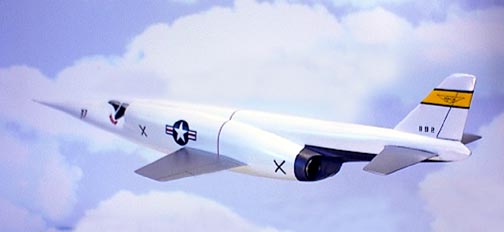 After masking the glazings, intakes, and exhaust openings, the
model was given five coats of primer white (it took that much to cover the
filler). Each coat was lighted sanded before the other applied to hold down dust
specks and fill minor indentations. Once satisfied, I gave the model three more
coats of reefer white. The fuselage was masked at the exhaust area and this was
given a shooting of burnt iron. Lastly I masked the entire fuselage and shot the
wings and horizontal tailplanes SF (Santa Fe) Silver. Before removing the
masking the SF silver was polished out with a little SNJ Silver polishing
powder. Once masking was removed and a little touch up dispensed, I gave the
model two coats of FUTURE for decal prep.
After masking the glazings, intakes, and exhaust openings, the
model was given five coats of primer white (it took that much to cover the
filler). Each coat was lighted sanded before the other applied to hold down dust
specks and fill minor indentations. Once satisfied, I gave the model three more
coats of reefer white. The fuselage was masked at the exhaust area and this was
given a shooting of burnt iron. Lastly I masked the entire fuselage and shot the
wings and horizontal tailplanes SF (Santa Fe) Silver. Before removing the
masking the SF silver was polished out with a little SNJ Silver polishing
powder. Once masking was removed and a little touch up dispensed, I gave the
model two coats of FUTURE for decal prep.
The decals that came with the kit were unusable, as they were the dry transfer variety and were not in good shape. I used red trim film for the fuselage separation stripe and SuperScale National Insignia. The vertical tail's stripe was done using yellow and black trim film and some NASA/NACA decals that came with the 1996 IPMS/USA Nationals packet. They rest are all courtesy of Major Rob Gronovius. Thanks Rob, I couldn't have done it without them. Note that the NACA marked X-3 did not used the "DOUGLAS" name with the "X-3" on the front and also deleted the first two numbers of the USAF identification number
|
CONCLUSIONS |
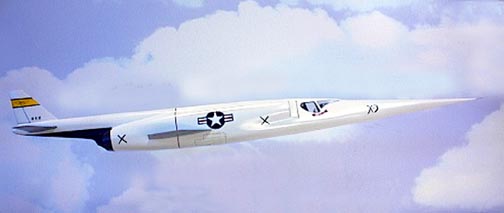 Seeing as how I built this kit in a much younger day, I had to
pick it up for the steal that I got it for. Seeing as how no other manufacturer
is likely to treat this aircraft to injected plastic, other than the somewhat
badly done 1/72 East European kit and the old Revell kit in S-scale or close, I
had to build it. I saw it at the Air Force Museum in 1982 and each time I
returned and have always wanted to build the plane again. Well, it's a long
bugger and the base for it is more befitting a 1/700-scale ship. But it's unique
and really not quite the project made out to be. This kit has recently been
re-released by Lindberg with upgraded decals, so I would not hesitate in telling
all X-planers in getting one.
Seeing as how I built this kit in a much younger day, I had to
pick it up for the steal that I got it for. Seeing as how no other manufacturer
is likely to treat this aircraft to injected plastic, other than the somewhat
badly done 1/72 East European kit and the old Revell kit in S-scale or close, I
had to build it. I saw it at the Air Force Museum in 1982 and each time I
returned and have always wanted to build the plane again. Well, it's a long
bugger and the base for it is more befitting a 1/700-scale ship. But it's unique
and really not quite the project made out to be. This kit has recently been
re-released by Lindberg with upgraded decals, so I would not hesitate in telling
all X-planers in getting one.
 January 2001
January 2001
Copyright ModelingMadness.com
If you would like your product reviewed fairly and fairly quickly by a site that has over 1,800 visits a day, pleasecontact the editor or see other details in the Note to Contributors.
Back to Reviews Page 2017